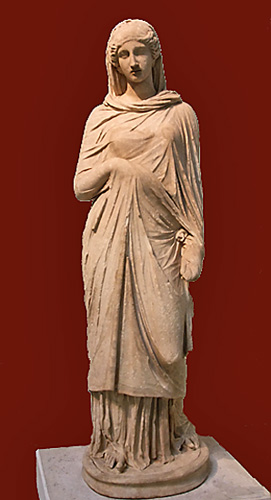
Marble funerary statue inscribed Publia Maximina
130-100 BCE
Marcia, the daughter of L. Marcius Philippus (consul 56 BCE), was born (c. 80 BCE) into one of Rome’s most ancient and revered families, the gens Marcia (see coin of Ancus Marcius). When, after the death of her mother, her father married the widow Atia maior in 59 BCE, Marcia became the stepsister of Octavia and Octavian (the future Emperor Augustus). Marcia was more than a worthy match for M. Porcius Cato; fifteen years his junior, she became his second wife sometime before 61 BCE. After five years of marriage, during which she bore him three children, Cato, in consultation with Marcia’s father Philippus, divorced his wife in order that his friend, the famous orator Q. Hortensius Hortalus, a man thirty-five years her senior, could marry her. While Julius Caesar questioned Cato's motives, it is said Cato acted out of consideration for Hortensius' situation as a wealthy widower without a male heir (Hortensia is thought to have been his daughter by his wife Lutatia). Marcia, out of wifely fidelity and obedience, consented to this highly controversial arrangement, but it is worth noting that Cato obtained the approval of her father first. Marcia fully experiences the impact of the looming internecine struggle between Caesar and Pompey on the fragile stability of both public and private life in late Republican Rome. At this moment of intense uncertainty for the house of Cato, aligned as he was on the side of Pompey, and more generally for Rome, Lucan explores the themes of civil war and chaos through a deft conflation of the rites and rituals of marriage and funeral. The first half of this passage (326-349) alludes to Hortensius' funeral rites and contains Marcia's poignant petition to Cato for the renewal of her status as his wife; the second half (350-371) describes the bittersweet nuptials, a grimly foreboding perversion of the traditional marriage ceremony. Marcia lived on as an exemplum of marital fidelity and wifely obedience, first in the exercises produced in the rhetorical schools (see Quintilian, Institutiones 3.5.11, 13; 10.5.13) and then in the writings of the early Church Fathers (see Tertullian, Apologeticum 39.12-13). An epic poem, the Bellum civile is written in dactylic hexameter. For further interpretation of this passage (including its relationship to another “Marcia” episode in Silius Italicus, Punica 6.415-451 and 497-520), see Henriette Harich, “Catonis Marcia,” Gymnasium 97 (1990), 212-223. For the virtues of Lucan's Marcia as a Roman wife, see Mulhern's article "Roma(na) Matrona" in Bibliography.